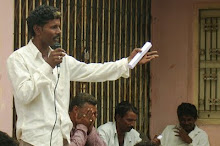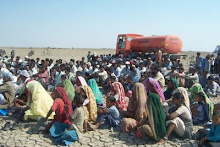Counterview:
Ahmedabad: Sunday, 04 January 2015.
The Gujarat
government has acknowledged its complete failure in ameliorating the plight of
the women involved in cultivating salt in hundreds of agariyas (saltpans) in
the Little Rann of Kutch in Gujarat. A still unreleased “research” study,
running into 40-odd pages, the Gender Resource Centre, operating directly under
the department of women and child, Gujarat government, has said that, despite
existence of large number of government schemes, “there is no change in the
economic, social and health related problems of the women working in agariyas.”
Nearly 43,000
men and women from 108 villages situated on the border of the Little Rann work
in the agariyas for eight months in a year, living in sub-human conditions,
mainly poorly knit tents, without electricity, drinking water, health
facilities and education for children. Belonging to other backward class (OBC)
communities, they have been demanding recognition as “forest dwellers”, as the
Little Rann is a Wild Ass Sanctuary, as it would give them right to own land
under the forest rights law.
Admitting
that women have to work for longer working hours – 15 hours continuously on an
average as against the men who work for 10 hours – the study, titled “An
Overview of the Condition of Women Working in Agariyas”, and based on an
interaction with 33 women working in agariyas, says that women are not even
provided with even “health health facilities”, as a result of which one
witnesses “a high incidence of health-related problems among women.” The result
is that, there is a “higher incidence of widows among agariya families compared
to others.”
“Women begin
their day at around 4 in the morning, cleaning up the tent, cooking food, go to
the agariyas to work with menfolk, look after children, and sleep at 9.00 pm”,
the study reports.
“Skin-related
diseases are widely prevalent among agariya cultivators. The emergency 108
service, available in villages, refuses to reach up to them in agariyas, which
are situated at least 7 kilometres inside the Little Rann. Nor is there any
availability of vehicles, especially during night hours so that they could
reach a hospital”, the study says, adding, women further feel discriminated as
the “mobile health vans, which reach agariyas just once a week, have no women
health workers, and women refuse to reveal gynecological problems to the men
health workers.”
The study
says, “One witnesses a higher incidence of malnutrition among women and
children during the months they work in agariyas. Despite hard labour they do,
they face a shortage of of nutritious food. Living in the Little Rann they are
unable to access ghee, oil, milk, green vegetables, fruits, and the vicious
circle of lack of these food items continues unabated. It is only once in a
fortnight that they are able to go to their villages to access food items.”
Pointing towards
poor literacy rates among agariya women, with just about one-third of them
literate, the study quotes them as saying that they are unable to make their
children study continuously. “Many children work in agariyas. They live in the
Little Rann for eight months, and go to school only for four months, as a
result of which they are often very weak in studies”, the study admits,
suggesting failure of the state-sponsored Kanya Kelavni girl enrolment drive.
“There is no emphasis on ensuring that agariya girls study”, it underlines.
During group
discussions, the study says, the agariya women complained of lack of
availability of drinking water in the Little Rann. “The tankers provide water
to us next to the agariyas just once or twice a day. They pour water into the
tanks put up by us. We bath just twice or thrice a week. Often we must bring
water in buckets on bicycles several kilometres away. The river is far away.
There is a real shortage of water”, an agariya woman is quoted as saying.
Other
problems the agariya women face include no toilets in the Little Rann,
drunkenness among male agariyas leading to high incidence of domestic violence,
inability to marry girls in non-agariya families, lack of social life, and so
on. The study has asked the Gujarat government's urgent intervention,
recommending, among other things:
·
Regular
supply of water through tanker
·
Setting
up of mobile toilets
· Provision
of all-weather tents which could withstand strong winds and torrential rains
· Provision
of basic facilities at the agariya doorsteps, including food items, including
vegetables and other nutritious food at regular interval
· Regular
visit by mobile health vans consisting of female health workers, with
availability of basic medicines needed to address gynecological problems women
·
Provision
facilities to vaccinate of infants
·
Provision
of mobile schools for out of school children
· Regular
availability of basic information about government schemes meant for women
·
Special
programmes to empower especially young women
















.jpg)
.jpg)
.jpg)
.jpg)













No comments:
Post a Comment